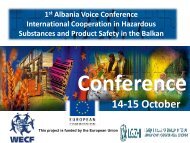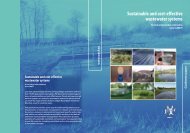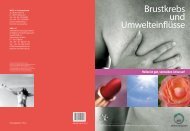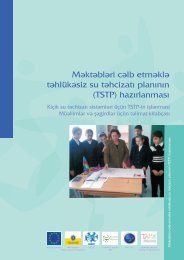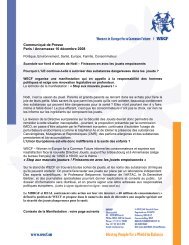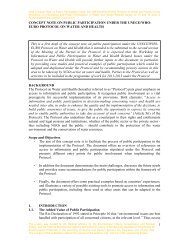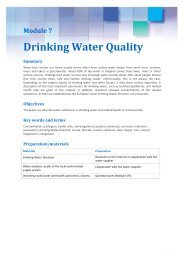Environmental measures to improve children's health - Health and ...
Environmental measures to improve children's health - Health and ...
Environmental measures to improve children's health - Health and ...
You also want an ePaper? Increase the reach of your titles
YUMPU automatically turns print PDFs into web optimized ePapers that Google loves.
<strong>Environmental</strong> <strong>measures</strong><strong>to</strong> <strong>improve</strong>children’s <strong>health</strong>The CEHAPE NGO competition for rewarding good practicein <strong>children's</strong> environment <strong>and</strong> <strong>health</strong> has taken place fora second time. Awards will be presented <strong>to</strong> winners ineight categories on 11 March 2010 at the World <strong>Health</strong>Organization’s (WHO) European Region MinisterialConference on Environment <strong>and</strong> <strong>Health</strong> in Parma, Italy.How the awards startedThe CEHAPE Awards were inspired by the launch of theChildren‘s Environment <strong>and</strong> <strong>Health</strong> Action Plan for Europe(CEHAPE) <strong>and</strong> the Budapest Declaration signed bygovernments of the WHO’s European region in June 2004during the Fourth Ministerial Conference on Environment<strong>and</strong> <strong>Health</strong>. The first competition was launched in 2006 <strong>to</strong>highlight the progress being made in the countries <strong>and</strong> thefirst CEHAPE awards were presented at the WHO intergovernmentalmid-term review of progress in Vienna in 2007.The prize-giving <strong>and</strong> presentation of the winning projectsin Vienna was welcomed by WHO <strong>and</strong> by many nationalministries of <strong>health</strong> <strong>and</strong> environment in Europe.This encouraged the organisers: <strong>Health</strong> <strong>and</strong> EnvironmentAlliance, Women in Europe for a Common Future,ECOFORUM, <strong>and</strong> International Society of Doc<strong>to</strong>rs forthe Environment Austria <strong>to</strong> run the competition a secondtime with the presentation of the awards at the WHOMinisterial Conference on Environment <strong>and</strong> <strong>Health</strong>, Parma,Italy on 11 March 2010.Awards 2010: Showcasing projects<strong>to</strong> protect children’s <strong>health</strong>The theme of this year‘s ministerial meeting is "Children‘s<strong>Health</strong> in a Changing Environment", which reflects wellwhat the entrants <strong>to</strong> this competition have addressed intheir projects.A <strong>to</strong>tal of 114 entries were received from 31 countriesin the WHO European region. We were delighted <strong>to</strong> have asimilar number of entries <strong>to</strong> the 1st CEHAPE awards, <strong>and</strong> <strong>to</strong>find the quality of the projects <strong>to</strong> be much higher this year.Many more of the participants clearly highlighted howdrawing on local expertise <strong>and</strong> working in partnership withother groups, government <strong>and</strong> the private sec<strong>to</strong>r makes animportant difference <strong>to</strong> achieving goals. Almost all showedhow media attention helped raise public awareness <strong>and</strong>often attracted the interest of policy makers, teachers <strong>and</strong>other educational experts not directly involved in activities.Many groups also showed how they made their projectssustainable, <strong>and</strong> indicated how their experience wastransferable <strong>to</strong> other settings or how it had even beenreplicated by others.The winning projects are youth associations, women‘sorganisations, schools, institutes <strong>and</strong> othernon-government groups that make a major contribution<strong>to</strong> improving children‘s environmental <strong>health</strong> in Europe.The awards <strong>and</strong> the wider CEHAPE processThe first four categories selected for awards reflect thepriorities for children‘s environmental <strong>health</strong> of the WHOEuropean region.4 CEHAPE Awards, March 2010
These four "Regional Priority Goals" in the Children‘sEnvironment <strong>and</strong> <strong>Health</strong> Action Plan for Europe (CEHAPE)are:• Water & sanitation• Accident prevention <strong>and</strong> physical activity• Air quality• Hazardous chemicals <strong>and</strong> radiation.The four additional categories represent two important <strong>and</strong>growing challenges <strong>and</strong> two potential solutions:• Mobility• Climate protection• Youth participation• Schools.The challenges for Europe are first un<strong>health</strong>y mobility with atrend <strong>to</strong>wards greater use of private road vehicles, increasedair pollution <strong>and</strong> road accidents, <strong>and</strong> second climate change,which is expected <strong>to</strong> exacerbate the existing major causes ofill-<strong>health</strong> in children, such as diarrhoeal <strong>and</strong> respira<strong>to</strong>rydisease.The two categories that represent the potential solutions areyouth participation <strong>and</strong> schools. Young people who are activein both schools <strong>and</strong> youth groups are themselves becominga major force of energy <strong>and</strong> change in addressing <strong>health</strong>problems associated with environmental causes.In Parma, prizes of a cheque of 1,000 Euros will be presented<strong>to</strong> the winner in each of the eight categories of the CEHAPEAwards 2010.This booklet features the eight winning projects.It describes the problem identified by the groups, theactivities they conducted <strong>and</strong> their achievements. All theentrants <strong>to</strong> this competition are featured on the CEHAPE<strong>Health</strong>ier Environments for Children website (http://cehape.env-<strong>health</strong>.org).We thank all those groups who entered the competition<strong>and</strong> urge them <strong>to</strong> continue their valuable work.The winning projects were selected following careful evaluationby more than 20 expert judges. The organisers would like <strong>to</strong>thank these judges who gave their time <strong>and</strong> expertise. They arefeatured on pages 14-15 <strong>and</strong> further details are also availableon the CEHAPE <strong>Health</strong>ier Environments for Children website(http://cehape.env-<strong>health</strong>.org).We thank the following Ministries for their sponsorship of theCEHAPE Competition <strong>and</strong> Award Ceremony:• Federal Ministry of Agriculture, Forestry, Environment <strong>and</strong>Water Management - Division on Transport, Mobility, HumanSettlement <strong>and</strong> Noise, Austria• Joint-Interministerial Conference on Environment <strong>and</strong> <strong>Health</strong>in charge of NEHAP, Belgium• Ministry of the Environment, Denmark• Federal Environment Agency (Umweltbundesamt), Germany• Federal Ministry for the Environment, Nature Conservation<strong>and</strong> Nuclear Safety, Germany• Ministry of Housing, Spatial Planning <strong>and</strong> the Environment,the Netherl<strong>and</strong>s• Ministry of the Environment, Norway• Ministry of <strong>Health</strong> <strong>and</strong> Care Services, Norway• Ministry of the Environment, Sweden.We take this opportunity <strong>to</strong> urge all governments <strong>and</strong> foundations<strong>to</strong> invest in programmes which replicate effective <strong>and</strong> sustainablecommunity projects, such as those highlighted in this booklet,throughout countries of WHO European Region <strong>and</strong> beyond.Genon Jensen,<strong>Health</strong> <strong>and</strong> Environment Alliance (HEAL)Sascha Gabizon,Women in Europe for a Common Future (WECF)Hanns Moshammer,International Society of Doc<strong>to</strong>rs for the Environment (ISDE) AustriaFifth Ministerial Conference on Environment <strong>and</strong> <strong>Health</strong>, WHO European Region5
Water & Sanitation1Country: LithuaniaProject: Voluntary moni<strong>to</strong>ring of wells,Marijampolė CountyOrganisation: Station of Nature Research<strong>and</strong> <strong>Environmental</strong> EducationRepresentative: Arūnas BalsevičiusEmail: gtess@mari.omnitel.netSchool children keepwell water safePiped water is a rarity in rural areas of Lithuania. This meansthat more than one in four of the country‘s population relieson drinking water from wells. This water is not always safe<strong>to</strong> drink. The contamination is both biological <strong>and</strong> chemical,with high levels of nitrates in the water being a seriousconcern.The Station of Nature Research <strong>and</strong> <strong>Environmental</strong>Education started a community clean up of the water inwells over 10 years ago. Today, student teams from 37 schoolsin Marijampolė County are gathering water samples fromthese wells in a project financed by the administrations ofMarijampolė County municipalities.Once the samples are collected <strong>and</strong> the analysis of the watercompleted, the school children provide the feedback <strong>to</strong> thecommunity. They also give information on the <strong>health</strong> risksassociated with different types of water contamination <strong>and</strong>advice on how households can keep the wells clean <strong>and</strong> safe.Special attention is given <strong>to</strong> wells used by households offamilies with children.The sample gathering <strong>and</strong> information work by the students isongoing. Each gathering <strong>and</strong> testing of samples in the projectarea takes place over the course of three years. To keep thevolunteers motivated, the best groups of students are invitedon a free annual outing.In operation over a decade, the project now has available theresults of three, three-year cycles of tests. The results showthat water quality in the wells is improving. The moni<strong>to</strong>ring<strong>and</strong> education is producing clear benefits, which is motivatingfor everyone involved.Each year, new results are presented at an annual scientificconference. They are also shared with the municipalityauthorities that fund the project <strong>and</strong> with newspaper edi<strong>to</strong>rs<strong>and</strong> television reporters.Investigations at the wellin the village of Pilviskiai.6 CEHAPE Awards, March 2010
Accident Prevention& Physical Activity2Country: United KingdomProject: Child Safety Week 2009Organisation: Child Accident Prevention TrustRepresentative: Katrina PhillipsEmail: katrina.phillips@capt.org.ukA week that makesa difference <strong>to</strong> children’s safetyPreventable accidents are the second biggest childhood killerin the UK <strong>and</strong> a leading cause of disability. At least 100,000children are admitted <strong>to</strong> hospital each year with accidentalinjuries. Children from the poorest families are 13 times morelikely <strong>to</strong> die from accidental injury <strong>and</strong> three times more likely<strong>to</strong> be admitted <strong>to</strong> hospital.The Child Accident Prevention Trust (CAPT) hasdemonstrated the increasing impact of Child Safety Week.Last year, an estimated 6.5 million people were reachedthrough mail-outs <strong>and</strong> participation in local events. Mediacoverage reached almost half of all parents in Engl<strong>and</strong>.Front cover of the Ideas Booklet "Safer, Together"produced for Child Safety Week 2009 in the UK by theChild Accident Prevention Trust.Local events were made easy <strong>to</strong> organise because CAPTprovides free posters, fact sheets <strong>and</strong> an "Ideas booklet" withquizzes <strong>and</strong> games. Community organisations were able <strong>to</strong>attract mothers <strong>and</strong> children <strong>to</strong> take part in light-heartedactivities which also conveyed practical child safety messages.Some groups provided feedback on the materials developedfor Child Safety Week 2009. For example, according <strong>to</strong> theSure Start Children‘s Centre in Staffordshire: "Parents enjoyquizzes <strong>and</strong> will participate freely, it’s fun but informative.Great for evaluating where areas of safety are lacking".A <strong>to</strong>tal of 70,000 ideas booklets were distributedor downloaded from CAPT’s Child Safety Week website.Nine per cent of the parents surveyed said that they had sincetaken action <strong>to</strong> <strong>improve</strong> child safety as a result of Child SafetyWeek. The <strong>to</strong>p three things they did were:• Practised road safety with children• Moved matches or lighters out of children’s reach• Moved household cleaners or tabletsout of children’s reach.Independent market research has also found a high level ofawareness of Child Safety Week among the poorest parents,whose children are far more likely <strong>to</strong> be killed or seriouslyinjured in accidents.Fifth Ministerial Conference on Environment <strong>and</strong> <strong>Health</strong>, WHO European Region7
Air Quality3Country: BelgiumProject: Educational project for primary schoolOrganisation: The Flemish Institute for <strong>Health</strong>Promotion <strong>and</strong> Disease Prevention, the Flemish Agencyfor Care <strong>and</strong> <strong>Health</strong>, <strong>and</strong> Flemish Local <strong>Health</strong> NetworksRepresentative: Sara ReekmansEmail: sreekmans@limburg.beschools helped in the pilot testing of the project guide <strong>and</strong>educational materials. Once refined, these materials weremade widely available.Children in a Belgian kindergarten watch the indoorair quality indica<strong>to</strong>r.Keeping "refreshingly cool"in the classroomFor several years, environmental <strong>health</strong> workers from theFlemish Local <strong>Health</strong> Networks had been receiving questionsfrom teachers about how <strong>to</strong> <strong>improve</strong> air quality in theclassroom. Meanwhile, evidence was emerging thatventilation in schools was often poor. The Flemish Institutefor <strong>Health</strong> Promotion <strong>and</strong> Disease Prevention <strong>and</strong> theFlemish Agency for Care <strong>and</strong> <strong>Health</strong> decided that it wastime <strong>to</strong> act. Together with the Flemish Local <strong>Health</strong>Networks, they initiated a project called Lekker Fris, or"refreshingly cool" (www.lekkerfris.be).The first step was <strong>to</strong> distribute a poster <strong>and</strong> a flyer about theproject <strong>to</strong> every primary school in Fl<strong>and</strong>ers, the Flemishspeaking part of Belgium. It provided five simple steps <strong>to</strong>improving indoor air quality. After a collaborative process <strong>to</strong>develop the project <strong>and</strong> its materials, teachers in 15 primarySince January 2008, schools have been able <strong>to</strong> join the project.Teachers receive materials for 3-4 lessons, includingcrosswords, a song, drawings, a game, <strong>and</strong> a play, which theysay are fun <strong>and</strong> easy <strong>to</strong> use. The school borrows a h<strong>and</strong>-heldCO 2 indica<strong>to</strong>r, which children can underst<strong>and</strong> <strong>and</strong> learn <strong>to</strong> usethemselves. When the air is bad <strong>and</strong> urgent action is needed,a red light shows; a yellow light indicates poor air qualityin the classroom, <strong>and</strong> a green light indicates that all is well.The project organisers found that once a few schools hadstarted activities, media coverage in newspapers <strong>and</strong> onchildren‘s television attracted other schools <strong>to</strong> join.Evidence that the project is a success comes from severalsources. First, a recent evaluation by the Fl<strong>and</strong>ers governmentincluded a small number of primary schools that are takingpart in the project. The government report findings suggestedthat indoor air quality in these schools had <strong>improve</strong>d.At the same time, the teachers have rated the project highly.They say that the children benefit from learning about theimportance of ventilation as well as from fresher air in theclassroom.Following requests from secondary schools, the FlemishInstitute, the Flemish Agency for Care <strong>and</strong> <strong>Health</strong> <strong>and</strong>the Local <strong>Health</strong> Networks are now working on a similarinitiative for older children.8 CEHAPE Awards, March 2010
Hazardous chemicals &radiation4Country: RussiaProject: Reducing the risks of lead <strong>to</strong> childrenOrganisation: Far Eastern <strong>Environmental</strong><strong>Health</strong> FundRepresentative: Petr SharovEmail: psharov@fe<strong>health</strong>fund.orgChanging the earth<strong>to</strong> prevent lead poisoningEight years ago, Petr Sharov at the Far Eastern<strong>Environmental</strong> <strong>Health</strong> Fund looked at research from BunkerHill in Idaho, USA where action had been taken <strong>to</strong> reducelead contamination in the gardens of family homes. BunkerHill is an area contaminated by lead mining <strong>and</strong> smeltingplants. Knowing that the same problem existed in the miningareas of Dalnegorsk District, he decided <strong>to</strong> copy thesuccessful US model.He began work before he had managed <strong>to</strong> secure fullfunding for the project. Early activities included mapping themining areas for lead <strong>and</strong> cadmium, which were considered<strong>to</strong> be the two main <strong>and</strong> most <strong>to</strong>xic pollutants. In 2007,when full funding became available, medical teamsmoni<strong>to</strong>red local children for lead levels in their blood <strong>and</strong>provided information <strong>to</strong> parents on how <strong>to</strong> reduce theirchildren‘s exposure.educational advice <strong>to</strong> parents <strong>to</strong>ok place. By 2009, only 11%of children had lead levels above the safety limit.The challenge now is <strong>to</strong> reach families in the <strong>to</strong>wn of RudnayaPristan – the most contaminated part of the valley.During the first round of activities, the project activities didnot reach this area. About 60% of the 500 children living inthis community have blood lead levels above 10 ug/dl.Lead poisoning of children exists in many parts of Russia,Central Asia countries of Eastern Europe. The project wasexpensive (US$500,000 over two years) but the findingsshow that it works. The project would not have been possiblewithout the partnership of Blacksmith Institute <strong>and</strong> GreenCross Switzerl<strong>and</strong>. The organisers say that it is already beingcopied by a non-governmental organisation in Kazakhstan.They hope it can also be used as a model in other areas ofRussia where there is lead contamination.However, the biggest task, as in the Bunker Hill clean-upproject, was <strong>to</strong> remove lead-contaminated soil wherechildren play. Priority was given <strong>to</strong> playgrounds of youngchildren where lead in the soil was measured at over 500parts per million. Thanks <strong>to</strong> the efforts of the Far Eastern<strong>Environmental</strong> <strong>Health</strong> Fund, the contaminated <strong>to</strong>p-layer soil<strong>and</strong> s<strong>and</strong> in seven kindergartens has now been replaced withclean earth. This represents a <strong>to</strong>tal area 16,400 square meters.The benefits for children‘s <strong>health</strong> have been encouraging.In 2007, 22% of children in the Dalnegorsk District had bloodlead levels over 10 ug/dl (international safety st<strong>and</strong>ard). Overthe next two years the playground soil replacements <strong>and</strong>Children are tested for lead levels in their blood.Fifth Ministerial Conference on Environment <strong>and</strong> <strong>Health</strong>, WHO European Region9
Mobility5Country: AustriaProject: 'Mobility management – PORG moves'Organisation: PORG Volders grammar schoolRepresentative: Franz LeebEmail: porg-volders@tsn.atStudents promote free publictransportStudents at the PORG Volders grammar school in the Tyrolarea of Austria decided they were fed up with the noise<strong>and</strong> pollution from traffic on a nearby mo<strong>to</strong>rway. They wereworried about its effects on their <strong>health</strong> <strong>and</strong> unhappy thatmost of the private cars had only one person in them.They were also angry that public transport was so expensivethat it did not provide a real alternative. Mobility needed <strong>to</strong>be better managed!A group of"environmentalist" students worked with theirheadmaster <strong>to</strong> raise awareness of what needed <strong>to</strong> change.They asked doc<strong>to</strong>rs <strong>to</strong> come <strong>and</strong> speak <strong>to</strong> them about the<strong>health</strong> concerns related <strong>to</strong> poor mobility, <strong>and</strong> a provincialofficial gave a talk about a new policy which reduced themo<strong>to</strong>rway speed limit in the Tyrol <strong>to</strong> 100 kilometres per hour.The findings of a school questionnaire <strong>and</strong> several workshopswere used <strong>to</strong> provide information for posters about theproject. These were pinned up around the school. Finally, ademonstration by 25 students <strong>and</strong> teachers was organised,which created quite a stir.The group from PORG Volders marched from the school onthe main road <strong>to</strong> the nearby <strong>to</strong>wn. They carried banners <strong>and</strong>each wore their own "GehZeug", which is a wooden framethe size of a car - <strong>to</strong> indicate their message (see pho<strong>to</strong>).The demonstration <strong>to</strong>ok up the equivalent space of morethan 25 cars <strong>and</strong> inevitably caused a slowing of the traffic.This attracted the attention not only of the drivers but alsoof passers-by <strong>and</strong> the local media. Fortunately, the local policehad been willing <strong>to</strong> support the event.The school head master in charge of the project admits thatthe project has not managed <strong>to</strong> reduce transit traffic throughthe Tyrol. However, fewer students <strong>and</strong> teachers are usingprivate cars. The school has seen an almost 50% increase innumbers arriving by bicycle, which has required an extension<strong>to</strong> the cycle parking area.At the same time, newspapers <strong>and</strong> radio stations havereported on the project. The media discussion has allowedgrievances about the high cost of travel on public transport <strong>to</strong>surface. More students, teachers <strong>and</strong> members of the publicare talking about the problems caused by unsatisfac<strong>to</strong>rypolicy on mobility <strong>and</strong> transport. They hope it will encouragelocal policy makers <strong>to</strong> act.Students at the PORG Volders school in Austria held up private cars<strong>and</strong> lorries <strong>to</strong> protest against local transport policies. The schoolbanner reads: 'PORG Volders moves'.10 CEHAPE Awards, March 2010
Climate protection6Country: ArmeniaProject: Sun energy in ArmeniaOrganisation: Armenian Women for <strong>Health</strong><strong>and</strong> <strong>Health</strong>y EnvironmentRepresentative: Elena ManvelyanEmail: office@awhhe.amUsing summer sunshine <strong>to</strong>boost <strong>health</strong> <strong>and</strong> happinessCoughs, colds, bronchitis <strong>and</strong> other respira<strong>to</strong>ry diseases area major threat <strong>to</strong> the <strong>health</strong> of small children in Armenia.With harsher winters predicted as a result of climate change,the situation is set <strong>to</strong> worsen unless energy for heating<strong>and</strong> hot water becomes more cheaply <strong>and</strong> easily available.Armenian Women for <strong>Health</strong> <strong>and</strong> <strong>Health</strong>y Environmenthave found a solution <strong>to</strong> what they call the "energy poverty"that will be associated with climate change in ruralcommunities, namely solar energy.Although winters are cold, Armenia has 2,500 hours ofsunshine per year – a resource that the group has shown canbe used <strong>to</strong> create energy cheaply. The women‘s organisationhas worked with solar energy experts <strong>to</strong> set up an innovative<strong>and</strong> decentralised solar energy panel <strong>and</strong> plant at thekindergarten in Solak village. The <strong>to</strong>tal project cost was 3,000Euros.The new plant saves the kindergarten money <strong>and</strong> means thathot water is more available all the year around. Funds thatwould have otherwise gone on gas, wood <strong>and</strong> animal manurebills for the open fire are no longer required. The children‘s<strong>health</strong> benefits because un<strong>health</strong>y fumes from fire,including those created when plastics burn, are reduced.Poster reminds children that the sun is creating the powerfor their showers, heating, cooking <strong>and</strong> lighting.More hot water has made life at kindergarten much morecomfortable when winter temperatures fall very low.The children are <strong>health</strong>ier <strong>and</strong> happier. Teachers <strong>and</strong> kitchenstaff also benefit, <strong>and</strong> a sense of hope has been created in theentire community. The project has shown that communitiescan act <strong>to</strong> counter the erosion of living st<strong>and</strong>ards associatedwith climate change. As part of a follow-up project,the families of some of the children have had their own solarplants installed at home.Fifth Ministerial Conference on Environment <strong>and</strong> <strong>Health</strong>, WHO European Region11
Youth participation7Country: RussiaProject: Interactive environmental education<strong>and</strong> action programmeOrganisation: Green Light Youth Organisation,Vladivos<strong>to</strong>kRepresentative: Irina Fedorenko,Evgeniya SobolevaEmail: phedorenko@hotmail.comMobilising youth <strong>to</strong> keepnature in mindYoung people in Russia do not always know enough aboutthe importance of the natural environment for their <strong>health</strong><strong>and</strong> well-being. The problem for the organisers of thisproject was that those in authority who do know aboutthese issues are not always ready or have the capacity <strong>to</strong>share the information.The Green Light Youth Organisation in Vladivos<strong>to</strong>kembarked on an interactive environmental educationprogramme 18 months after Irina Fedorenko returned <strong>to</strong>Russia inspired by her visit <strong>to</strong> the World Youth Congressin Canada in August 2008, where she gained the support of"Be the change" (BTC) fund <strong>and</strong> Peace Child International.With her friend Evgeniya Soboleva <strong>and</strong> with help from thecity youth department, the project brought <strong>to</strong>gether sevenschools <strong>and</strong> three universities in an impressive series ofactivities that draw on the expertise of university professors,environmental organisations <strong>and</strong> local government officials.Between March <strong>and</strong> June 2009, 12 student trainers from theNGO "Trainers Union" completed courses on "The naturalenvironment as a way of thinking". They then went in<strong>to</strong> fourschools <strong>and</strong> talked <strong>to</strong> more than 500 children. This prompteda whole range of activities.For example, with the help of the Students Council of FarEastern University <strong>and</strong> Vladivos<strong>to</strong>k city administration,200 students <strong>to</strong>ok part in rubbish clearing projects in a park,a forest, mountain area <strong>and</strong> at a waterfall. Once the sites wereclear, the young people shared information with interestedonlookers <strong>and</strong> installed waste bins.School children hold up their drawings about recycling in aprogramme organised by the Green Light Youth Organisationin Vladivos<strong>to</strong>k, Russia.In the Far Eastern State Technical University, a paper recyclingsystem was set up. On the campus, student brigadeswho work on the Russian railways in the summer, knownas "provodnik", also helped with project activities.They constructed bird houses in trees around the universitybuildings <strong>to</strong> remind students of the disappearance of species.On 6 June 2009, a festival of pho<strong>to</strong>s <strong>and</strong> videos called"Look… Environment by youth" was held in Vladivos<strong>to</strong>k StateUniversity of Economy <strong>and</strong> Service where young peopleshared their reflections on environmental problems <strong>and</strong>possible solutions. A <strong>to</strong>tal of 82 certificates were awarded<strong>to</strong> the most active participants in project activities <strong>and</strong> eightletters of appreciation were given <strong>to</strong> experts who hadprovided advice <strong>to</strong> the project.An estimated 2,000 young people have taken part in theseenvironmental <strong>measures</strong> of the project in the Far Easternregion of Russia. Irina Fedorenko believes that each hasgained some "real life" knowledge of nature, its relationship<strong>to</strong> our <strong>health</strong>, <strong>and</strong> the importance of small, individual actions.One thous<strong>and</strong> 12-17 year-olds have received training onsustainable development including: choosing <strong>health</strong>ier food;keeping the environment clean; <strong>and</strong> <strong>health</strong>ier lifestyles forthemselves <strong>and</strong> their families.12 CEHAPE Awards, March 2010
Schools8Country: TajikistanProject: Green schoolsOrganisation: Youth of the 21st CenturyRepresentative: Umidjon UlugovEmail: umed.ulugov@youth21.tjStudent environmentalmanagementcomes <strong>to</strong> the classroomConditions in schools in Tajikistan are not always as good asthey should be. Classrooms are often untidy <strong>and</strong> cold inwinter. But the Youth of the 21st Century organisation in18 schools in Dushanbe has changed all that in a project thatis fully self-sustaining. Little wonder it has won the politicalsupport of Tajik‘s education <strong>and</strong> environment ministries.Activities are organised with the support of Green Patrol,a youth movement with 16,000 members operating in70 schools. The project began by introducing an interactive,computer-based manual. The main themes in this "textbook"are the environment, <strong>health</strong>y living, leadership <strong>and</strong> voluntaryactivity. In a collaborative process, it was decided that schoolsin the project would be rated allowing them <strong>to</strong> competeagainst each other.The students work individually on the contents <strong>and</strong> activitiesoutlined in the book. They then organise activities, such asclean-ups of classrooms <strong>and</strong> outdoor spaces, low-cost schoolheating, free distribution of boiled water, <strong>and</strong> the creationof posters <strong>to</strong> inform <strong>and</strong> decorate the classroom walls.The project has achieved a substantial reduction in diarrhoealdisease <strong>and</strong> although other <strong>health</strong> benefits have not beenformally measured, parents have thanked the project teamfor what they perceive as a reduction in cases of flu.The students are proud of their achievements <strong>and</strong> ofbecoming managers of their own environment. By sellingplastic <strong>and</strong> waste paper <strong>to</strong> local recycling companies, manyschools have created a fund <strong>to</strong> cover their costs. On average,each school has earned the equivalent of US$1,200.During 2010, another 100 schools are expected <strong>to</strong> join theproject. In addition, the interactive textbook will be featuredin a Ministry of Education report on informal education.School children have the chance <strong>to</strong> learn school <strong>and</strong>environmental management skills from the"interactive book" used in the Green Schools project inTajikistan.Fifth Ministerial Conference on Environment <strong>and</strong> <strong>Health</strong>, WHO European Region13
The award judgesHere is a brief introduction <strong>to</strong> the children’s <strong>health</strong> <strong>and</strong> environment experts who generously gave their time<strong>to</strong> act as judges in this competition. We take this opportunity <strong>to</strong> thank them all.Category 1 Water <strong>and</strong> SanitationCategory 2 Accident Prevention &Physical ActivityThor Axel Stenströmis a microbiologist at the Swedish Institute for Infectious Disease Control, anexpert at the S<strong>to</strong>ckholm Environment Institute (SEI) <strong>and</strong> professor at theNorwegian University of Life Sciences.Contact: thor-axel.stenstrom@smi.seRalf Otterpohlis a university professor in civil <strong>and</strong> environmental engineering <strong>and</strong> direc<strong>to</strong>r ofthe Institute of Wastewater Management <strong>and</strong> Water Protection Management,Hamburg University of Technology (TUHH), Germany.Contact: ro@tuhh.deMihaela Vasilescuis a senior scientist at the Institute of Public <strong>Health</strong> Bucharest, Romania. She isvice-president of EURACHEM Romania <strong>and</strong> president of the NGO "Environment<strong>and</strong> <strong>Health</strong>", a member of WECF.Contact: mihaelavasilescu@clicknet.roHanns Moshammeris a university teacher at the Medical University of Vienna working in the field ofenvironmental <strong>health</strong>. His main research fields are environmental <strong>and</strong>occupational epidemiology. He is president of the International Society ofDoc<strong>to</strong>rs for the Environment (ISDE, www.isde.org) <strong>and</strong> of the Austrian ISDEaffiliate (ÄrztInnen für eine gesunde Umwelt, www.aegu.net).Contact: hanns.moshammer@meduniwien.ac.atLilian Corrais a paediatrician/neona<strong>to</strong>logist in Argentina. She founded the AsociaciónArgentina de Médicos por el Medio Ambiente (AAMMA) <strong>and</strong> is co-founder of theInternational Network on Children’s <strong>Health</strong> Environment <strong>and</strong> Safety (INCHES).Contact: cisde@arnet.com.arCategory 3 Air PollutionCategory 4 Hazardous Che micals &radiationPeter Helmsis head of the University of Aberdeen, Department of Child <strong>Health</strong>, UK. He servedas Chair of the Respira<strong>to</strong>ry <strong>and</strong> Allergy group of the European Commission’sSCALE initiative that formed part of the EU’s response <strong>to</strong> CEHAPE.Contact: p.j.helms@abdn.ac.ukNino Künzliis Professor of Public <strong>Health</strong> <strong>and</strong> the Chair of Public <strong>Health</strong> at the Medical Schoolof the University of Basel. He was supported by Laura Perez, PhD, a researcher atthe Swiss Tropical <strong>and</strong> Public <strong>Health</strong> Institute in Basel.Contact: Nino.Kuenzli@unibas.chHans-Guido Mückeis air quality <strong>and</strong> <strong>health</strong> manager at the WHO Collaborating Centre for Air QualityManagement <strong>and</strong> Air Pollution Control (WHO’CC) at the Federal EnvironmentAgency, Berlin, Germany.Contact: hans-guido.muecke@uba.deGerd Oberfeldis a general practitioner working in public <strong>health</strong> department of the Salzburgregion, Austria. He specialises in environmental <strong>health</strong> e.g. epidemiology, airpollution, water pollution, noise, ionizing <strong>and</strong> non-ionizing radiation <strong>and</strong> <strong>health</strong>effects. He is direc<strong>to</strong>r of the postgraduate course in environmental medicine <strong>and</strong>spokesperson on environmental medicine at the Austrian Medical Association.Contact: gerd.oberfeld@salzburg.gv.atDr. Tony Fletcheris a senior researcher <strong>and</strong> lecturer at the Public <strong>and</strong> <strong>Environmental</strong> <strong>Health</strong>Research Unit, London School of Hygiene & Tropical Medicine. He contributed <strong>to</strong>the International Agency for Research on Cancer evaluations of carcinogenicagents <strong>and</strong> European Union-funded programmes of risk assessments of chemicalcontaminant exposures in waterContact: <strong>to</strong>ny.fletcher@lshtm.ac.ukMore details about each of the judges can be found on the CEHAPE <strong>Health</strong>ier Environments for Children website: http:// cehape.env-<strong>health</strong>.org14 CEHAPE Awards, March 2010
Category 5 MobilityCategory 6 Climate protectionRoelof Wittinkis direc<strong>to</strong>r of I-CE – Interface for Cycling Expertise, an international nongovernmentalorganisation. It aims <strong>to</strong> strengthen the position of cycling <strong>and</strong>cyclists in order <strong>to</strong> contribute <strong>to</strong> societal goals, such as poverty alleviation,<strong>health</strong>, <strong>and</strong> climate protection.Contact: roelof.wittink@cycling.nlAngela van der Kloofis a mobility consultant at Mobycon, an independent research <strong>and</strong> consultingcompany in traffic, transport <strong>and</strong> urban <strong>and</strong> rural planning.Contact: a.v<strong>and</strong>erkloof@mobycon.nlPeter van den Hazelis a medical doc<strong>to</strong>r <strong>and</strong> environmental <strong>health</strong> specialist.He is chair <strong>and</strong> founder of INCHES - the International Network on Children's<strong>Health</strong>, Environment <strong>and</strong> Safety, <strong>and</strong> Vice President of the <strong>Health</strong> <strong>and</strong>Environment Alliance (HEAL). He is a board member of the Dutch Associationof <strong>Environmental</strong> Medicine <strong>and</strong> the International Society of Doc<strong>to</strong>rs for theEnvironment (ISDE).Contact: P.J.van.den.Hazel@inter.NL.netHartmut Graßlis former direc<strong>to</strong>r of the 'Physics of the Atmosphere' division at the Max-Planck-Institute for Meteorology in Hamburg <strong>and</strong> professor emeritus of meteorology atthe University of Hamburg. He holds honorary doc<strong>to</strong>rates in Hungary, Germany<strong>and</strong> Russia.Contact: hartmut.grassl@zmaw.deCategory 7 Youth participationCategory 8 SchoolsReka Prokaiis a former CEHAPE youth delegate with a degree in agricultural engineering.She <strong>to</strong>ok part in the Budapest Ministerial Conference in 2004 <strong>and</strong> was a youthdelegate on the CEHAPE Task Force 2006-2007.Contact: prokai.reka@gmail.com, rprokai@vati.huStephan Böse-O´Reillyis assistant professor at the Institute of Public <strong>Health</strong>, University for <strong>Health</strong>Sciences, Hall, Austria. He is the secretary of the International Network Child<strong>Health</strong> Environment <strong>and</strong> Safety (INCHES) <strong>and</strong> Chair of the German NetworkChildren’s <strong>Health</strong> <strong>and</strong> Environment.Contact: stephan.boeseoreilly@umit.atCosima Pilzis an Educa<strong>to</strong>r <strong>and</strong> Mobility Consultant at the Styrian Centre of<strong>Environmental</strong> Education (Umwelt-Bildungs-Zentrum Steiermark) in Austria.She is coordina<strong>to</strong>r of the CEHAPE process in Austria on behalf of the AustrianFederal Ministry of Agriculture, Forestry, Environment <strong>and</strong> Water Management.Contact: cosima.pilz@ubz-stmk.atAymeric Blanchethas been the Direc<strong>to</strong>r of the French Air Pollution Prevention Association (APPA)since 2008 where he has contributed <strong>to</strong> the development of an integratedapproach <strong>to</strong> air pollution <strong>and</strong> climate change in public policy <strong>and</strong> raisedawareness among stakeholders of the <strong>health</strong> impact of indoor air pollution.Contact: Email: aymeric.blanchet@appa.asso.frNita Chaudhuriworked for a number of years for the South Riverdale Community <strong>Health</strong> Centre,Toron<strong>to</strong>, Canada. In collaboration with WECF, she develops training on interactiveworkshops.Contact: Nita.Chaudhuri@wecf.euMaria Hawleis head of the educational department of Climate Alliance Austria.Maria coordinates educational projects in the field of climate protectionthroughout Austria.Contact: maria.hawle@klimabuendnis.atFifth Ministerial Conference on Environment <strong>and</strong> <strong>Health</strong>, WHO European Region15
HEAL in actionProtecting children in Europe through advocacy<strong>and</strong> educational <strong>to</strong>olsThe <strong>Health</strong> <strong>and</strong> EnvironmentAlliance (HEAL) aims <strong>to</strong> make betterknown that the consequences ofa polluted environment are far worsefor our children than for ourselvesas parents <strong>and</strong> adults. Childrenabsorb a greater proportion of what they eat <strong>and</strong> the airthey breathe than adults, <strong>and</strong> have longer lives ahead ofthem <strong>to</strong> endure the effects.We have both projects <strong>and</strong> materials specifically focusingon children‘s <strong>health</strong>.Fun fact sheetsFor children themselves, we have a series of colourful,educational fact sheets about climate change <strong>and</strong> thequality of outdoor <strong>and</strong> indoor air. A chirpy pixie called Elfexplains <strong>to</strong> 5-11 year olds about breathing, our lungs <strong>and</strong>air pollution with the help of quizzes, games <strong>and</strong> colour-indrawings. These sheets were developed with the help ofscientific evidence from the European Respira<strong>to</strong>ry Society<strong>and</strong> in partnership with the European Lung Foundation(ELF), from whom the "Elf" character gets his name.The leaflets are available in eight languages.Fact sheets: "Dirty air <strong>and</strong> your lungs"(outdoor air); "Dirty airindoors <strong>and</strong> your lungs"; <strong>and</strong>, "Climate change <strong>and</strong> yourlungs". All fact sheets available in English, French, German,Greek, Italian, Polish, Russian <strong>and</strong> Spanish. Adult versions ofthe fact sheets are also available. Full details <strong>and</strong> downloadavailable at: http://cehape.env-<strong>health</strong>.orgComic strip s<strong>to</strong>riesA comic strip book on hazardous chemicals <strong>and</strong> <strong>health</strong> hasbeen created for teenagers <strong>and</strong> young adults. "Choosingour Future" with s<strong>to</strong>ries that focus on children‘s exposure<strong>to</strong> hazardous chemicals, untested chemicals <strong>and</strong>human infertility, "chemical cocktails" <strong>and</strong> cosmetics, <strong>and</strong>pesticides use in agriculture is available in three languages(English, French <strong>and</strong> Dutch). It aims <strong>to</strong> build awareness <strong>and</strong>HEAL's postcard urged local authorities <strong>to</strong> act.increase action <strong>to</strong> break the links between harmfulchemicals in our environment <strong>and</strong> their effects onour <strong>health</strong>. It has been used in youth workshops <strong>and</strong> isparticularly popular in educational institutes, schools<strong>and</strong> youth groups.S<strong>to</strong>pping unnecessary pesticide sprayingOur advocacy work during recent revisions of Europeanpesticide legislation called for avoiding pesticide sprayingwhere children play. Our postcard <strong>to</strong> local authoritiesin Europe called for unnecessary "cosmetic" spraying ofpesticides <strong>to</strong> be s<strong>to</strong>pped. Going pesticide free whereverpossible helps <strong>to</strong> protect children‘s <strong>health</strong>.Recently, our Sick of Pesticides campaign has looked atthe use of weed killer <strong>and</strong> insecticide spraying in schools.We began by producing a short guide on pesticides usedin schools. We surveyed local authorities about whichpesticides they were using in schools <strong>and</strong> the <strong>measures</strong>they <strong>to</strong>ok <strong>to</strong> avoid risks <strong>to</strong> children‘s <strong>health</strong>. The surveyfound that at least four potentially cancer-causingpesticides are being used.UK pesticides survey: "Pesticides - a <strong>to</strong>xic education?A survey of pesticides in UK schools", available atwww.pesticidescancer.eu. See also Pesticides in schools: shortguide.16 CEHAPE Awards, March 2010
Sharing the bestHEAL makes every attempt <strong>to</strong> share good examples ofchildren‘s <strong>health</strong> <strong>and</strong> environment projects, particularlyfrom our member organisations, many of whom focus onchildren’s environmental <strong>health</strong>. For example, HEAL’s VicePresident, Peter van den Hazel is Chair of the InternationalNetwork on Children’s <strong>Health</strong> Environment <strong>and</strong> Safety(INCHES).Genon Jensen, HEAL‘s Executive Direc<strong>to</strong>r, is the officialrepresentative for <strong>health</strong> non-governmental organisationson the committee that steers the Environment <strong>and</strong> <strong>Health</strong>Ministerial Process.CEHAPE "<strong>Health</strong>ier environments for children" is at:http://cehape.env-<strong>health</strong>.org/As well as co-organising the CEHAPE Awards, our website,"<strong>Health</strong>ier environments for children" provides informationon dozens of "case studies" of different projects in manyEuropean countries. The website provides key informationfor non-governmental organisations about the Children‘sEnvironment <strong>and</strong> <strong>Health</strong> Action Plan for Europe (CEHAPE)<strong>and</strong> is linked <strong>to</strong> the World <strong>Health</strong> Organization‘s officialCEHAPE website section.Prize-winning youthvideoHEAL‘s experimental short film made by youngpeople in five countries was screened during theWHO Ministerial Conference in Budapest in 2004.This participa<strong>to</strong>ry video project gave very young<strong>and</strong> older youths in Belgium, France, Hungary,Russia <strong>and</strong> the UK an opportunity <strong>to</strong> speak abouthow the environment is affecting their <strong>health</strong> –<strong>and</strong> <strong>to</strong> tell policy makers what should be doneabout it. The video entitled "It‘s our world, Ourfuture <strong>to</strong>o: Young people’s voices on environment<strong>and</strong> <strong>health</strong> priorities" won the Children’s<strong>Environmental</strong> <strong>Health</strong> Recognition Award fromthe US <strong>Environmental</strong> Protection Agency in 2006.The comic strip book "Choosing our Future" helps <strong>to</strong> answer thequestion: How does continual exposure <strong>to</strong> man-made chemicalsaffect our <strong>health</strong>?The <strong>Health</strong> <strong>and</strong> Environment Alliance (HEAL) aims <strong>to</strong>promote a <strong>health</strong>y environment for <strong>health</strong>y people.It represents a diverse network of more than 60 groupsrepresenting citizens', patients', women‘s groups, <strong>health</strong>professionals, <strong>and</strong> environmental advocates across Europe.Working at the European level, HEAL focuses on chemicals,pesticides, climate change, air quality, mercury, children‘svulnerabilities <strong>and</strong> many other aspects of EU policy that arerelevant <strong>to</strong> people‘s <strong>health</strong> <strong>and</strong> the environment.Fifth Ministerial Conference on Environment <strong>and</strong> <strong>Health</strong>, WHO European Region17
WECF in actionProtecting children through safe "nesting"<strong>and</strong> safe <strong>to</strong>ysWomen in Europe for a CommonFuture (WECF) puts greatimportance on protecting childrenbecause they are the mostvulnerable members of society.All of us share a responsibility <strong>to</strong>protect children from harmfulpollution, which can cause long term, sometimesirreversible, physical <strong>and</strong> mental damage. Our aim is <strong>to</strong>ensure that children can grow up in a <strong>health</strong>y environment- without being exposed <strong>to</strong> hazardous chemicals in theirfood, <strong>to</strong>ys <strong>and</strong> environment – so that their brains <strong>and</strong>bodies can develop <strong>to</strong> fullest potential.Protecting children will help reduce the incidence ofchronic diseases, reproductive problems <strong>and</strong> behaviourproblems – <strong>and</strong> even cancer, the incidence of which hasgrown tremendously over the past decades.WECF has two major projects that concentrate onimproving children‘s environment. They are the Nestingproject <strong>and</strong> the Safe Toys Coalition.Project "Nesting"When expecting a baby, you start wondering, planning <strong>and</strong>questioning. Things are changing <strong>and</strong> exciting times areahead. Everything should be ready for the child. The babyshould feel snug <strong>and</strong> safe in her or his new home, the nest.Project Nesting (www.projectnesting.org/) provides support<strong>to</strong> parents who want <strong>to</strong> choose renovation materials,furniture <strong>and</strong> baby-products that are safe <strong>and</strong> <strong>health</strong>y fortheir newborn child. The project aims at providing newparents <strong>and</strong> professionals in child <strong>health</strong> <strong>and</strong> childcare withprecise information <strong>and</strong> helpful practical advice so that theycan make informed choices for <strong>health</strong>ier products <strong>and</strong>adopt new practices.Nesting informs, via a web platform <strong>and</strong> training sessions,about the quality of the air <strong>and</strong> environment inside homes<strong>and</strong> in day care centres, <strong>and</strong> describes the way in whichproducts such as furniture <strong>and</strong> carpeting, cleaning agents<strong>and</strong> baby care products can affect indoor air quality,<strong>and</strong> lead <strong>to</strong> the exposure of children <strong>to</strong> <strong>to</strong>xic substances.Since its launch, 50,000 visi<strong>to</strong>rs have used the website,which is available in eight languages (Dutch, English,French, German, Greek, Hungarian, Latvian <strong>and</strong> Spanish).More languages are being added every year. Otheractivities involve training <strong>and</strong> workshops for parents <strong>and</strong>childcare professionals.In 2009, Project Nesting conducted the "test your nest"campaign in five EU countries in partnership with theFrench national consumer protection institute (INC). Parentswere offered a unique opportunity <strong>to</strong> test the air quality intheir baby‘s room. A test kit was provided <strong>to</strong> families inFrance, Germany, Greece, the Netherl<strong>and</strong>s <strong>and</strong> the UK.Following specific testing guidelines, parents were able <strong>to</strong>test for pollutants such as formaldehyde <strong>and</strong> other volatileorganic compounds (VOCs).The testing process was both reliable <strong>and</strong> very simple.The testing samplers made available in the kit were placedin the baby‘s room for a period of seven days <strong>and</strong> then sent<strong>to</strong> a certified labora<strong>to</strong>ry where the results were analysed.The INC reviewed the findings <strong>and</strong> published the results inits monthly magazine: 60 Millions de Consommateurs(60 million consumers). The individual test results were alsosent <strong>to</strong> all the parents who participated.The findings of the "test your nest" action showed that theproject is making nurseries safer for babies. The air qualityin the baby‘s room was best in homes where parents wereinformed about good ventilation, <strong>and</strong> who were making aneffort <strong>to</strong> regularly open the windows <strong>to</strong> ventilate it.18 CEHAPE Awards, March 2010
<strong>health</strong> effects?ogenic <strong>and</strong> mutagenicoductive <strong>and</strong> hormone system,cer riskment <strong>and</strong> the hormone system,ductive systemic by inhalation, impaires fertility,ent of child’s brainrupts the hormone systemtagenic, <strong>to</strong>xic: causes severe burns,tagenic <strong>and</strong> <strong>to</strong>xic <strong>to</strong> reproductionimpaires fertility. Effects on theone systemrupts the hormone system <strong>and</strong> fertilityrupts fertilityent <strong>and</strong> the hormone system.atic life, disrupts the hormone systemBased on SIN-List www.chemsec.orgSafe Toys CoalitionWECF has set an objective for a world free of <strong>to</strong>xic or unsafe<strong>to</strong>ys <strong>and</strong> is leading a coalition of international NGOs <strong>to</strong>make this aim achievable.The coalition intends putting the issue of hazardous <strong>to</strong>yson the international agenda <strong>and</strong> working closely withpartners on better legislation for safe <strong>to</strong>ys as a way <strong>to</strong> helpensure a <strong>health</strong>y future for our children.Millions of children worldwide are still exposed <strong>to</strong> <strong>to</strong>xiccontaminants in <strong>to</strong>ys. Despite repeated declarations thatsubstances such as lead, plastic softeners (phthalates) orformaldehyde can adversely affect <strong>health</strong>, they are stillfound in <strong>to</strong>ys.The <strong>to</strong>y industry does not give much attention <strong>to</strong> this fact."It’s distressing <strong>to</strong> know that profit is made at the expenseof children‘s <strong>health</strong>," says Alex<strong>and</strong>ra Caterbow, WECF‘s <strong>to</strong>ysexpert <strong>and</strong> co-founder of the Safe Toys Coalition. "Many ofthe substances found in <strong>to</strong>ys, which are shown <strong>to</strong> affect<strong>health</strong>, are simply not necessary."Organisations from different countries have joined the SafeToys Coalition <strong>to</strong> help ensure that, in future, <strong>to</strong>ys can nolonger harm children but only give joy. The Coalition willadvocate for safe <strong>to</strong>ys worldwide through a dialogue withindustry, politicians <strong>and</strong> consumers.The Safe Toys Coalition has drafted a joint statement whichincludes a call for a further revision of the EU Toys Directive.The Coalition believes that this is needed <strong>to</strong> push retailersProtect children –avoid hazardous chemicals !WECFWomen in Europe for a Common FutureWECF guideSafe <strong>to</strong>ysWECF haspublished a ToysGuide in 17languages whichprovides tips onhow <strong>to</strong> choose<strong>to</strong>xic- free <strong>to</strong>ys.<strong>to</strong> move <strong>to</strong>wards safe <strong>and</strong> <strong>to</strong>xic-free products – so that allour children will benefit. Toys are products that form aglobal market. It should be regulated <strong>and</strong> globally secure.More Information on the Safe Toys Coalition:www.wecf.eu/english/articles/2009/12/<strong>to</strong>ystrainingmunich-2009.phpWECF Safe Toys Guide (in 17 languages) is available here:www.wecf.eu/english/publications/2009/publications-<strong>to</strong>ysguide.phpWhy arechildren particularlyvulnerable?Children are much more sensitive <strong>to</strong> exposure <strong>to</strong><strong>to</strong>xic chemicals than adults because of their largerskin surface in proportion <strong>to</strong> their weight, theirhigher respira<strong>to</strong>ry volume <strong>and</strong> their increasedmetabolic rate. Consequently, they absorbproportionately more hazardous chemicals thanan adult. At the same time, their immune <strong>and</strong>nervous systems are still developing.Children are exposed <strong>to</strong> a variety of hazardouschemicals from many different sources. Hazardouschemicals can be found in cosmetics, furniture<strong>and</strong> other everyday products. Even the smallestamounts of hazardous chemicals are sufficient <strong>to</strong>harm the development of a child – sometimeswith lifelong consequences. The increasing allergy<strong>and</strong> cancer rates demonstrate this.Women in Europe for a Common Future – WECF –was created in 1994 following the 1992 Rio Earth Summit,<strong>to</strong> give women a stronger voice in sustainable development<strong>and</strong> environmental policy, with the aim of balancingenvironmental, <strong>health</strong> <strong>and</strong> economic perspectives, WECFstrives for a <strong>Health</strong>y Environment for All.20.03.2009 10:57:42 UhrFifth Ministerial Conference on Environment <strong>and</strong> <strong>Health</strong>, WHO European Region19
Helping children‘s <strong>health</strong> in Europe: achievements of the winning projects• Drinking water from wells in rural Lithuania is safer <strong>to</strong> drink thanks <strong>to</strong>Station of Nature Research <strong>and</strong> <strong>Environmental</strong> Education Station.• An estimated 6.5 million people received information on preventingchild accidents <strong>and</strong> injury during Child Safety Week 2009 organised bythe Child Accident Prevention Society, UK.• The Flemish Institute for <strong>Health</strong> Promotion <strong>and</strong> Disease Prevention <strong>and</strong>partners have been so successful in helping <strong>to</strong> <strong>improve</strong> indoor airquality in kindergartens in Belgium that plans are underway <strong>to</strong> extendthe programme <strong>to</strong> secondary schools.• The number of children with lead in their blood above internationallyrecognised safety limits has been halved thanks <strong>to</strong> the work of the FarEastern <strong>Environmental</strong> <strong>Health</strong> Fund, Russia.• Students <strong>and</strong> teachers at the PORG Volders grammar school in theAustrian Tyrol have given a message <strong>to</strong> local authorities <strong>and</strong> <strong>to</strong>the public that greater mobility <strong>and</strong> better <strong>health</strong> could be achievedif public transport were less expensive.• A village school in Armenia now generates hot water fromsolar-powered electricity, cutting the school’s power bills <strong>and</strong>improving the classroom environment, thanks <strong>to</strong> Armenian Womenfor <strong>Health</strong> <strong>and</strong> <strong>Health</strong>y Environment.• The work of the Green Light Youth Organisation in Vladivos<strong>to</strong>k hasresulted in 2,000 young people taking small, individual steps <strong>to</strong><strong>improve</strong> environment <strong>and</strong> <strong>health</strong>.• A substantial reduction in the number of students suffering fromdiarrhoeal disease is just one of the results of a programme in schoolsin Tajikistan where Youth of the 21st Century are offering schoolmanagement <strong>and</strong> environment training.Organisers of the AwardsGénon JensenExecutive Direc<strong>to</strong>r<strong>Health</strong> <strong>and</strong> Environment Alliance28 Boulevard CharlemagneB-1000 BrusselsTel: +32 2 234 3641Fax: +32 2 234 3649E-mail: genon@env-<strong>health</strong>.orgWebsite: www.env-<strong>health</strong>.orgFundersSascha GabizonInternational Direc<strong>to</strong>rWomen in Europe for a Common FuturePO Box 130473507 LA Utrecht, Netherl<strong>and</strong>sTel: +31 30 23 10 300Fax: +31 30 23 40 878Email: sascha.gabizon@wecf.euWebsite: www.wecf.eu• Federal Ministry of Agriculture, Forestry, Environment <strong>and</strong> WaterManagement – Division on Transport, Mobility, Human Settlement<strong>and</strong> Noise, Austria• Joint-Interministerial Conference on Environment<strong>and</strong> <strong>Health</strong> in charge of NEHAP, Belgium• Ministry of the Environment, Denmark• Federal Environment Agency (Umweltbundesamt), Germany• Federal Ministry for the Environment, Nature Conservation<strong>and</strong> Nuclear Safety, Germany• Ministry of Housing, Spatial Planning <strong>and</strong> the Environment,the Netherl<strong>and</strong>s• Ministry of the Environment, Norway• Ministry of <strong>Health</strong> <strong>and</strong> Care Services, Norway• Ministry of the Environment, Sweden.Hanns MoshammerInternational Society of Doc<strong>to</strong>rsfor the Environment (ISDE) Austria(ÄrztInnen für eine gesunde Umwelt)Grosse Mohrengasse 39/21020 Vienna, AustriaTel: +43 1216 34 22, Fax: +43 1216 34 2215Email: hanns.moshammer@meduniwien.ac.atWebsite: www.aegu.netWe thank the following Ministries <strong>and</strong> Agencies for their sponsorship of the CEHAPE Competition <strong>and</strong> Award Ceremony:<strong>Health</strong> <strong>and</strong> Environment Alliance (HEAL) <strong>and</strong> Women in Europe for a Common Future (WECF) thank the European Commission for its financial support.The st<strong>and</strong>points expressed in this publication do not necessarily reflect the official views of the funders.Edi<strong>to</strong>r: Diana G. Smith Edi<strong>to</strong>rial team: Genon Jensen, Anne Stauffer, Gill Erskine <strong>and</strong> Diana Smith, <strong>Health</strong> <strong>and</strong> Environment Alliance (HEAL) <strong>and</strong> Sascha Gabizon, Anne Barre <strong>and</strong>Chantal van Denbossche, Women in Europe for a Common Future (WECF). Design <strong>and</strong> lay-out: Véronique GrassingerThis brochure is printed on recycled paper with environmentally-friendly ink. It can be downloaded on the CEHAPE <strong>Health</strong>ier Environments for Children website (cehape.env-<strong>health</strong>.org).




